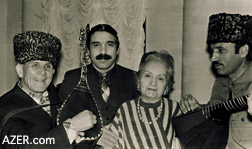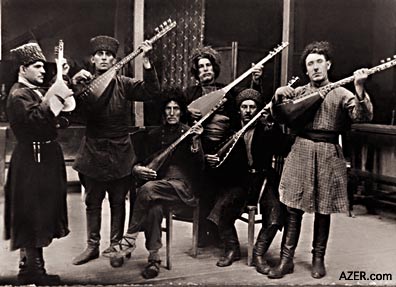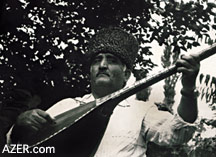|

Winter 2004 (12.4)
Pages
56-57
Discoveries
The Poet Minstrels of Azerbaijan
by Anna
Oldfield
  It's
like a conversation with God, Professor Maharram Gasimli explained,
as a young "ashug" student began to play "Ruhani"
(which means "spiritual" in Azeri) on his "saz",
and sure enough, as the musical theme developed, I could hear
the metallic notes of the traditional string instrument seeming
to search for a connection, revel in the glory of what had been
found, and then return to the original theme refreshed and renewed,
like a mystic returning home from a mountaintop experience of
enlightenment. It's
like a conversation with God, Professor Maharram Gasimli explained,
as a young "ashug" student began to play "Ruhani"
(which means "spiritual" in Azeri) on his "saz",
and sure enough, as the musical theme developed, I could hear
the metallic notes of the traditional string instrument seeming
to search for a connection, revel in the glory of what had been
found, and then return to the original theme refreshed and renewed,
like a mystic returning home from a mountaintop experience of
enlightenment.
Suddenly, I understood what I had read many times but had never
fully comprehended. Ashug music is not just entertainment. It
is a spiritual experience - a unique way in which the Azerbaijani
people commune with the Infinite by means of music and poetry.
A chill ran through me as I nodded in agreement - it was like
"a conversation with God". And this was only the first
day of class.
In 2002, I had originally enrolled in the graduate program at
the University of Wisconsin as a student of classical Russian
Literature. Never would I have dreamed that two years later I
would be awarded Fulbright Fellowship for 10 months to do research
in Baku, studying traditional poet - minstrels called "ashugs"
who are the inheritors of an oral tradition, which dates back
to pre-historical Turkic Shamanism.
I first became interested in ashug art from reading the great
heroic and romantic epics such as Koroghlu (Son of a Blind Man)
and Ashug Garib (the story of a poor minstrel who falls in love
with a rich man's daughter). These works are the heritage of
peoples throughout the Turkic-speaking world. I was impressed
by the sophistication and narrative complexity of these works
and amazed that these lengthy epics had been passed via oral
tradition for hundreds of years and were still being performed
today.
Studying the Turkish Ashug tradition (a close cousin of the Azerbaijani
tradition) with Professor Sarah Atis at Wisconsin, I learned
that the singers of these traditional epics also compose original
songs on contemporary topics. I realized that Turkic oral narrative,
which both preserves the past while being responsive to the present,
has a depth and richness that is as complex and fascinating as
any written literature.
Women Ashugs -
Are There Any?
  Left: Amina Eldarova, the first woman folklorist to
study ashug art. Courtesy:
Azad Ozan Karimli. Left: Amina Eldarova, the first woman folklorist to
study ashug art. Courtesy:
Azad Ozan Karimli.
But one question had always puzzled me. All the ashugs that we
had read about in Western literature were men. Weren't there
any women ashugs? Professor Atis knew that there were a few in
Turkey but had heard once that there were many women ashugs in
Baku. Because of the lack of information about Azerbaijan in
the United States, no one knew for sure.
I was intrigued. Was it true? Were there many women minstrel
performers in Azerbaijan? And if so, why Azerbaijan? And did
their performances differ from that of male counterparts? How
were women ashugs viewed by society? Was the tradition continuing?
Were young women becoming ashugs? I had a million questions.
One of the greatest challenges for scholars in the U.S. who are
interested in Azerbaijani culture is the scarcity of information.
While a few Western musicologists have studied ashugs of Turkey
and Southern Azerbaijan (Iran), information about the ashugs
of the Republic of Azerbaijan (Northern Azerbaijan) is rare.
Information about women ashugs - anywhere - is virtually nonexistent.
After gathering what bits and pieces of information I could find
on the subject, and with an enormous amount of help from friends,
colleagues and scholars in the U.S. and Azerbaijan, I gradually
began to discover that there was a tradition of women ashugs
in Azerbaijan that dated back to the early 19th century. It had
started with a spunky, young woman from the region of Jabrayil
(now under military occupation by Armenians) called Ashug Pari.
She was famous for her quick-witted repartee, her masterful poetry,
and her ability to compete successfully against men in improvised
poetry contests called "deyishma".
While still in the States, I was able to obtain a copy of "The
Art of the Azerbaijani Ashug" (in Russian), which was written
by Azerbaijan's first ethnomusicologist (and student of Uzeyir
Hajibeyov), Amina Eldarova. The text was informative about the
tradition, but it did not discuss women's contribution to the
art. I learned that there was an organization of woman ashugs
called Ashug Pari Majlisi, based in Baku, but I did not know
about their activities.
Ocean of Resources

Above: Bozalganli Ashug Gadir,
Ashug Mirza Bayramov, Ashug Husein Bozalganli (sitting), Garachi
Oghlu Ivraham (Ibrahim), Ashug Sadig Sultan, Gazakhli Telli Mahammad.
Courtesy: Azad Ozan Karimli.
Every piece of information that I could gather contributed a
piece to the puzzle but left me with more questions than answers.
Fortunately, I was awarded a Fulbright Fellowship to travel to
Azerbaijan and research the topic.
Armed with stacks of questions
and a one-summer Azeri language course from Indiana University,
I gathered my husband and four-year-old son and headed for Baku.
It was like arriving on the shores of a vast ocean after following
a tiny trickle of water in a desert. I found that books, videos,
cassettes, even DVDs of ashugs - featuring both men and women
- were everywhere. Ashugs were on TV, on the radio. We even ran
into one of them while strolling on the Boulevard next to sea.
My whole family has become involved; my husband has helped enormously
with videotaping and digital editing, while my son has patiently
sat through many long concerts and has even constructed a small
saz out of plastic and rubber bands.
We traveled to Kurdamir (a mid-sized town in central Azerbaijan
about three hours west of Baku) to meet Ashug Ahmad, who at 86,
is one of the oldest living ashugs in Azerbaijan. We've also
seen performances of some of the youngest ashugs, age 10 or so,
at the annual Children's Ashug competition in Baku.
  Left: Ashug Bozalganli Khaligverdi. Courtesy: Azad Ozan Left: Ashug Bozalganli Khaligverdi. Courtesy: Azad Ozan
I have been fortunate to begin working with the wonderful and
talented members of Ashug Pari Majlisi, with many of Azerbaijan's
foremost experts in ashug music and literature, and with musicians
and scholars in a diverse variety of fields. In addition, my
affiliation with Azerbaijan State University of Culture and Arts
has given me a chance to take classes in traditional Azerbaijani
music and folklore, and to learn first hand from Ashug Ahliman,
Ashug Samira, Ashug Shargiyya, and a very talented group of ashug
students.
But what I enjoy most of all is watching ashug performances and
seeing how passionate the live performers are who love this music
and consider it to be the "spring of life" itself.
In the few months that I've been staying in Baku, I've learned
a tremendous amount.
My initial research has also made me realize how much more I
still need to learn to even begin to truly understand this deep
and complex art form which is so intimately tied to Azerbaijan's
past, present, and future. I've been deeply impressed by the
respect that Azerbaijani people have shown to their traditions
and heritage, and how attracted they are to their own musical
folklore. For an American, it is truly marvelous to see young
people deeply engaged in learning such a demanding traditional
art, which requires years of musical training and the memorization
of hundreds of poems. It speaks well for the health and dynamism
of this living tradition, despite the immense pressures stemming
from globalization and popular culture.
I have just begun my research here, and I can see that I will
have a busy and exciting year ahead. I hope that by the end of
my stay, I will have a greater insight into this living folkloric
tradition and the dynamic role that women play in keeping it
alive.
One of the great pleasures of working in Azerbaijan has been
experiencing their warm hospitality, and the help and support
that I have received from everyone that I have encountered. It's
a pleasure to do research here, and scholars who make their way
to Azerbaijan will not only find beautiful and meaningful traditions,
but immensely talented people who are eager to share them.
Azerbaijani folklore is preserved in so many different genres,
from carpet weaving to culinary arts and the ancient dances called
"yalli" which are still performed in villages. I hope
that as the international community becomes better acquainted
with Azerbaijan, more people will be motivated to travel here
to appreciate and study the richness of traditional culture that
Azerbaijan has to offer the world.
Anna Oldfield Senarslan is a
PhD candidate at the University of Wisconsin, Madison, in the
Department of Languages and Cultures of Asia. She is currently
spending a year of dissertation research at Azerbaijan State
University of Culture and Arts on a Fulbright/IIE Fellowship,
accompanied by her family.
Back to Index AI 12.4 (Winter
2004)
AI Home
| Search | Magazine
Choice
| Topics
| AI Store | Contact us
Other Web sites
created by Azerbaijan International
AZgallery.org | AZERI.org | HAJIBEYOV.com
|




